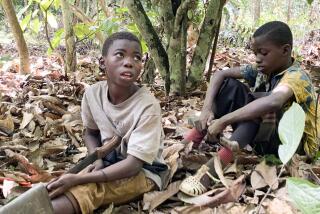County Weighs Action on Child Labor Issue
- Share via
Monroe High School senior Joseph Jung winces at the image: children trapped in dark hovels, stitching soccer balls 12 hours a day.
The children’s sweatshops may be in foreign lands, but Jung and a group of Monroe classmates are waging their own fight to end a practice that human rights groups say condemns millions of children to lives of misery.
Today, the Los Angeles County Board of Supervisors will consider a motion inspired by the Monroe students that will require companies selling soccer balls to the county to certify that the manufacturers used no child labor.
The county each year buys about 800 soccer balls, spending $5,000 to $7,000, that are used in county parks, juvenile halls and other programs.
The students’ crusade is part of an ongoing effort by Monroe’s law and government magnet program to end a practice that they say robs peers of their youth by working in dangerous conditions with few if any safeguards.
Last year, another Monroe class persuaded the Los Angeles Board of Education and the Los Angeles City Council to bar the purchase of balls from manufacturers known to use child labor.
“We are horrified by the human rights abuses of young children within countries like China, Pakistan, Indonesia and others,” said Jung, 17, who with his classmates has spent the fall semester studying child labor. “Children as young as 6 years old are taken from their homes and put into factories to stitch soccer balls while making a meager 60 cents a day. If I was in that situation, I would want someone to help me.”
The Monroe students’ efforts also are part of an international movement to stop the use of child labor, which affects about 250 million children worldwide, said Darlene Adkins, coordinator of the Washington-based Child Labor Coalition, whose 50 organizations battle the problem.
Adkins and other experts said that Pakistan produces about 90% of the soccer balls imported to the United States. Balls also are manufactured in China, Indonesia and other countries, she said.
Among the most visible critics of child labor is Craig Kielburger, a Canadian teenager whose international youth movement, Free the Children, has cast a spotlight on the subject, from his country’s Parliament to the U.S. Congress.
Kielburger launched his crusade after learning the story of Iqbal Masih, a Pakistani boy who was sold into bondage as a carpet weaver at age 4. At age 10 he escaped and became an outspoken critic of child exploitation until he was murdered in 1995.
Throughout the United States, schools have launched their own efforts, writing members of Congress and raising money for child labor groups. At Monroe, international law teacher Mark Elinson offered a two-week course last year about child exploitation after he saw a television program about Kielburger and Masih. The class stretched into a semester-long course that he is offering again this fall.
Thirty of Elinson’s students are studying the issue, hoping to capitalize on the gains made by last year’s class.
Last month, they sent the five supervisors a packet of material about child labor and soccer balls, urging action.
More to Read
Sign up for Essential California
The most important California stories and recommendations in your inbox every morning.
You may occasionally receive promotional content from the Los Angeles Times.










